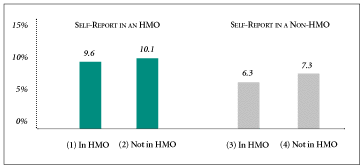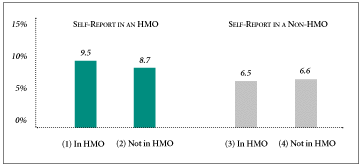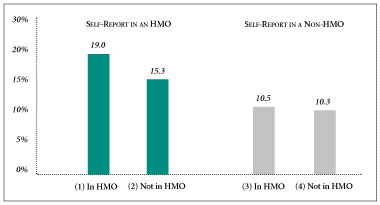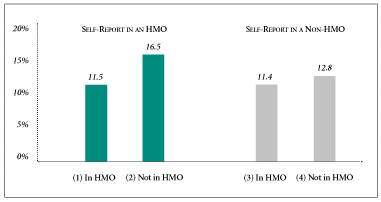
Health Care Perceptions and Experiences
It's Not Whether You Are in an HMO, It's Whether You Think You Are
Issue Brief No. 30
September 2000
James D. Reschovsky, J. Lee Hargraves
![]() urvey
results suggest that most people have negative attitudes about health maintenance
organizations (HMOs), even members of HMOs who are satisfied with their own
care. This Issue Brief illustrates how perceptions of HMOs may color peoples’
ratings of their own health care. According to new findings from the Center
for Studying Health System Change (HSC), differences in ratings between privately
insured people in HMOs and other types of insurance are in part attributable
to peoples’ perceptions of the type of health plan they are in, not the actual
type of plan they are covered by. These results, which have implications for
efforts to regulate managed care, suggest that reliance on attitudinal surveys
alone are likely to provide a somewhat distorted and more negative view of care
in HMOs, thereby exaggerating differences in how people assess the care they
receive.
urvey
results suggest that most people have negative attitudes about health maintenance
organizations (HMOs), even members of HMOs who are satisfied with their own
care. This Issue Brief illustrates how perceptions of HMOs may color peoples’
ratings of their own health care. According to new findings from the Center
for Studying Health System Change (HSC), differences in ratings between privately
insured people in HMOs and other types of insurance are in part attributable
to peoples’ perceptions of the type of health plan they are in, not the actual
type of plan they are covered by. These results, which have implications for
efforts to regulate managed care, suggest that reliance on attitudinal surveys
alone are likely to provide a somewhat distorted and more negative view of care
in HMOs, thereby exaggerating differences in how people assess the care they
receive.
Rating HMO Care
![]() he managed care backlash is a major force shaping health
care policy. Policy makers are responding to widely reported surveys indicating
that, although most people in either an HMO or another type of health plan are
satisfied with their care, a majority see managed care as reducing quality.
Most, therefore, favor some form of managed care regulation.
he managed care backlash is a major force shaping health
care policy. Policy makers are responding to widely reported surveys indicating
that, although most people in either an HMO or another type of health plan are
satisfied with their care, a majority see managed care as reducing quality.
Most, therefore, favor some form of managed care regulation.
Although surveys, including public opinion polls, reflect how people feel, they may not be good indicators of the relative quality of care people receive under different types of health insurance. Rather, the results of these surveys may be influenced by a conventional wisdom that HMOs provide inferior care. If people have these beliefs, they are likely to give responses that reinforce this notion, independent of the actual experiences they have had with their health care.
Apart from personal experience, the notion that HMOs provide inferior care might come from reports from family and friends, comments from their health care providers and media stories. As a group, health care providers tend to be dissatisfied with managed care for reasons that may or may not be related to health care quality. Research has shown that coverage of HMOs in the popular media tends to be based on anecdotes and is largely negative-the so-called HMO horror stories.
Experiences or Perceptions?
![]() o
examine how external factors might influence how people rate their own health
care, HSC used the fact that nearly one-quarter of privately insured people
do not correctly know whether they are in an HMO or not. The accuracy of self-reported
HMO membership was ascertained using data from two linked HSC surveys that are
part of the Community Tracking Study (see Data Sources).
In the Household Survey, respondents were asked whether they were covered by
an HMO plan. In the Insurance Followback Survey, insurers or others were queried
about health insurance products that covered privately insured Household Survey
respondents. By comparing consumer and insurer reports of health insurance plan
type, the accuracy of reporting could be determined. Among persons who incorrectly
report whether they are in an HMO or not, approximately equal numbers are in
HMOs and other, non-HMO types of plans (see Figure 1).
Non-HMO plans include preferred provider organizations (PPOs) and indemnity
insurance.
o
examine how external factors might influence how people rate their own health
care, HSC used the fact that nearly one-quarter of privately insured people
do not correctly know whether they are in an HMO or not. The accuracy of self-reported
HMO membership was ascertained using data from two linked HSC surveys that are
part of the Community Tracking Study (see Data Sources).
In the Household Survey, respondents were asked whether they were covered by
an HMO plan. In the Insurance Followback Survey, insurers or others were queried
about health insurance products that covered privately insured Household Survey
respondents. By comparing consumer and insurer reports of health insurance plan
type, the accuracy of reporting could be determined. Among persons who incorrectly
report whether they are in an HMO or not, approximately equal numbers are in
HMOs and other, non-HMO types of plans (see Figure 1).
Non-HMO plans include preferred provider organizations (PPOs) and indemnity
insurance.
By comparing assessments of health care among those who correctly and incorrectly identify their plan type, it is possible to investigate whether the type of plan- or perceptions about the type of plan-affects how people respond to questions assessing their care.
To understand how widespread perceptions of differences in the quality of medical care in HMOs and non-HMOs might cognitively affect responses to surveys, consider the following stylized statements:
- The health care I receive is good (bad). Therefore, I am satisfied (dissatisfied) with it.
- I am in an HMO (a non-HMO). I have heard that HMOs do not provide as good care as non-HMOs. Therefore, I am dissatisfied (satisfied) with my care.
- I have had bad (good) experiences with my health care. I have heard that HMOs do not provide as good care as non-HMOs. Therefore, I must be in an HMO (a non-HMO).
If all people respond in a manner consistent with the first statement, then survey results reporting on peoples’ satisfaction with their health care should be a good indicator of the relative quality of care, as people perceive it. In other words, if HMOs affect the health care people receive and they perceive these effects, then variations in assessments of care should correspond to their actual type of insurance, independent of what kind of plan they think they are covered by. However, if people respond to surveys in a manner consistent with the last two statements, then variations in assessments should correspond more with whether they think they are in an HMO or not, rather than their actual type of health coverage.
The Household Survey asked people questions assessing their health care. This Issue Brief focuses on four representative measures (see Survey Questions) as reported by the following groups:
- People who correctly think they are in an HMO
- People who think they are in an HMO, but are in a non-HMO
- People who think they are in a non-HMO, but are in an HMO
- People who correctly think they are in a non-HMO
If peoples’ responses to survey questions are consistent with their actual experiences, then ratings for groups 1 and 3 should be similar, and ratings for groups 2 and 4 should be similar. Moreover, if health care services differed between HMOs and non-HMOs, one would expect to see differences between ratings of those in HMOs (groups 1 and 3) and those in other types of insurance (groups 2 and 4). However, if peoples’ perceptions of differences between HMOs and non-HMOs color how they rate their care, then ratings for those who think they are in HMOs (groups 1 and 2) should be similar, ratings for those who think they are in non-HMOs (groups 3 and 4) should be similar and the greatest variation should be found between these two sets of groups.
Satisfaction with Care. Figure 2 shows the percentage of people in the four groups who expressed dissatisfaction with their health care in general. Expressions of dissatisfaction corresponded most closely to whether people think they are in an HMO or not, rather than whether they are actually enrolled in an HMO or not.
Once the type of plan people think they are in was accounted for, there was little difference in levels of dissatisfaction between HMO and non-HMO enrollees. Although many people in both HMOs and non-HMOs may base their responses on their actual care experiences, differences in levels of reported dissatisfaction between those in HMOs and non-HMOs appear to be influenced by the perception that care in HMOs is inferior to that in non-HMOs. There were similar findings when respondents were asked how satisfied they are with the choice they have of primary care physicians and of specialists.
Rating the Last Doctor’s Visit. Survey respondents who had a doctor’s visit in the past year were asked to rate how thorough the exam was during the latest visit. Figure 3 shows the percent rating the thoroughness as fair to poor. Because this question is grounded in a specific medical encounter, it should be influenced less by general perceptions of the quality of care in HMOs and non-HMOs. However, the results are similar to those of the general satisfaction measure. Perceptions of whether consumers were in an HMO or not appear to explain nearly all of the HMO/non-HMO differences.
In other words, patients’ responses among those who reported being in an HMO were similar, regardless of whether or not they were in an HMO. The same applies for those who reported being in a non-HMO. Similar results were found for questions rating how well the doctor listened and explained things during the last visit.
Patients’ Trust in Their Doctor. Researchers have found that, although people in HMOs may be satisfied with their care, they are concerned that they will not get high-quality care when they are seriously ill. Figure 4 shows whether patients trust their physicians to refer them to specialists when needed. The results are somewhat mixed, but most of the variation among the four groups of respondents corresponds with whether people think they are in an HMO or not. However, among those who think they are in HMOs, expressions of mistrust are more common among those actually in HMOs than in non-HMOs.
This suggests that, among persons who believe they are in HMOs, the type of plan they are in influenced their trust in doctors. This is consistent with the lower use of specialists in HMOs, although it is not clear why this pattern was found only among those who think they are in an HMO. It is not possible to determine whether patients can accurately determine when a referral to a specialist is medically advisable. Similar patterns of results were found when patients were asked whether they trust their doctors to put their medical needs above other considerations, and whether they thought their doctor was influenced by insurance rules when making medical decisions about their care.
People were also asked whether they agreed that that their doctor might prescribe unnecessary tests and procedures. The incentives to order tests and procedures are greater in non-HMO plans, where fee-for-service arrangements are common and care is less managed. Figure 5 illustrates that those who are in non-HMOs but thought they were in HMOs (group 2) were most likely to express agreement. This suggests that, in this case, patient confidence that physicians prescribe the right tests and procedures may be influenced by actual differences HMO and non-HMO enrollees observe in the care they receive. This pattern did not persist among those who thought they were in non-HMOs, however.
Figure 1
Accuracy of Reporting Type of Coverage among Privately Insured People
| PERCEIVED TYPE OF PLAN |
ACTUAL TYPE OF PLAN
|
|
|
HMO
|
NON-HMO
|
|
| HMO |
35%
|
13%
|
| NON-HMO |
11
|
41
|
Community Tracking Study Household Survey and Insurance Followback Survey, 1996-1997
Figure 2
|
Figure 3
|
Figure 4
|
Figure 5
|
Accounting for Health and Demographic Differences
![]() SC researchers
were concerned that these findings might result from differences in the demographic
or health profiles of HMO and non-HMO plan members or between those who correctly
and incorrectly report their plan type. To determine whether differences across
the four groups examined might explain the results, HSC repeated the analyses,
statistically accounting for disparities in gender, age, education, health status
and ethnicity.
SC researchers
were concerned that these findings might result from differences in the demographic
or health profiles of HMO and non-HMO plan members or between those who correctly
and incorrectly report their plan type. To determine whether differences across
the four groups examined might explain the results, HSC repeated the analyses,
statistically accounting for disparities in gender, age, education, health status
and ethnicity.
Differences between those who believed they were in HMOs and those who believed they were in non-HMOs shrank modestly for the doctor trust measures. However, the basic patterns found and the conclusions about the effect of perceptions on assessments of health care did not change.
Further Bias from Misreporting
![]() he findings
indicate that people’s assessments of their care are influenced by conventional
wisdom about the care provided by HMOs and non-HMOs. This means that differences
in assessments of health care between those in HMOs and non-HMOs do not represent
true differences in the care provided. Yet, the findings also show that many
people do not know what kind of health insurance they have. As a result, those
who compare health care assessments between people who self-report being
in HMOs or non-HMOs (the average of those in groups 1 and 2 versus the average
of those in groups 3 and 4) will obtain results that are even more biased than
if they compared assessments between those who are actually in HMOs and
non-HMOs (the average of those in groups 1 and 3 versus 2 and 4).
he findings
indicate that people’s assessments of their care are influenced by conventional
wisdom about the care provided by HMOs and non-HMOs. This means that differences
in assessments of health care between those in HMOs and non-HMOs do not represent
true differences in the care provided. Yet, the findings also show that many
people do not know what kind of health insurance they have. As a result, those
who compare health care assessments between people who self-report being
in HMOs or non-HMOs (the average of those in groups 1 and 2 versus the average
of those in groups 3 and 4) will obtain results that are even more biased than
if they compared assessments between those who are actually in HMOs and
non-HMOs (the average of those in groups 1 and 3 versus 2 and 4).
This additional source of bias is illustrated by comparing HMO/non- HMO differences for the four measures discussed here when survey respondents are categorized by self-reported and insurer-reported HMO status (see Figure 6). For each measure, HMOs are viewed relatively more favorably with non-HMOs when the insurer-reported plan type was used to categorize people instead of the self-reported plan type. For the first three measures, HMO enrollees still provided lower ratings, but differences were substantially smaller. For the last measure-trust that your doctor will not prescribe unnecessary tests and procedures-HMO enrollees expressed greater levels of trust when insurer-defined plan type was used, while no statistically significant difference was found when people were categorized by self-reported plan type. This potential for bias due to misreporting could extend to comparisons between HMOs and non-HMOs across other types of measures (e.g., service use or access to care).
Figure 6
Consumers’ Assessments of Their Health Care When HMO Status Is Based on Self-Report or Insurer Report
| MEASURE |
PERCENT OF HMO ENROLLEES MINUS PERCENT OF NON-HMO
ENROLLEES
|
|
|
ENROLLMENT BASED ON CONSUMER SELF-REPORT
|
ENROLLMENT BASED ON INSURER REPORT
|
|
| PERCENT DISSATISFIED WITH FAMILY’S HEALTH CARE IN GENERAL |
2.6%*
|
0.9%
|
| PERCENT RATING THOROUGHNESS OF EXAM DURING LAST DOCTOR’S VISIT AS FAIR TO POOR |
2.7*
|
1.7*
|
| PERCENT AGREEING DOCTOR MIGHT NOT REFER TO A SPECIALIST WHEN NEEDED |
7.7*
|
5.6*
|
| PERCENT AGREEING DOCTOR MIGHT PRESCRIBE UNNECESSARY TESTS AND PROCEDURES |
0.2
|
-2.2*
|
Community Tracking Study Household Survey and Insurance Followback Survey, 1996-1997
Implications for Policy Makers
![]() or some consumers, stereotypical views of how HMOs compare
with other types of health insurance interact with their perception of the type
of health insurance they have, and end up coloring how they rate their own health
care. By modest margins, privately insured consumers who thought they were in
HMOs rated their care lower on most measures than did those who believed they
were covered by other types of insurance. Yet, after controlling for perceptions
of plan type, HMO/non-HMO differences in consumer assessments shrink or even
disappear. This is the case for both general satisfaction questions and those
focused on a specific health care encounter. It is not possible to say whether
consumers rated their care lower because they believed they were in HMOs or
they believed they were in HMOs because they had different experiences. Results
for measures of patient trust in their physicians were mixed, however, suggesting
that perceptions and experiences might matter.
or some consumers, stereotypical views of how HMOs compare
with other types of health insurance interact with their perception of the type
of health insurance they have, and end up coloring how they rate their own health
care. By modest margins, privately insured consumers who thought they were in
HMOs rated their care lower on most measures than did those who believed they
were covered by other types of insurance. Yet, after controlling for perceptions
of plan type, HMO/non-HMO differences in consumer assessments shrink or even
disappear. This is the case for both general satisfaction questions and those
focused on a specific health care encounter. It is not possible to say whether
consumers rated their care lower because they believed they were in HMOs or
they believed they were in HMOs because they had different experiences. Results
for measures of patient trust in their physicians were mixed, however, suggesting
that perceptions and experiences might matter.
These findings suggest that policy makers and researchers should exercise caution in drawing conclusions about HMO and non-HMO differences from survey data. In addition, nearly all consumer surveys that ask about type of health insurance rely on consumers to categorize themselves into plan types. The results of this study suggest that even greater caution should be exercised when making comparisons between people in different types of health insurance, when self-reported plan type is used.
Survey results showing that people stating that they are in HMOs are less satisfied, or in other ways rate their care more poorly, than those in non-HMO plans are often used as evidence that the quality of care in HMOs is lower. Such results have provided justification for efforts to regulate managed care.
However, HSC’s research suggests that this evidence may not provide an accurate comparison of care provided in HMOs and other plans. Policy makers, where possible, should include objective measures about the quality of clinical care in HMOs and non-HMOs to inform policy discussions related to managed care. Similar information should be given to those who make choices among types of health insurance. This includes consumers choosing their type of health insurance coverage and employers or public purchasers who make decisions about the insurance offerings consumers are able to choose from.
Survey Questions
![]() urvey respondents were asked to answer questions assessing
health care on five-point scales indicating the level of satisfaction, the rating
of the last physician’s visit or agreement with statements about trust in one’s
physician. The four questions discussed in this Issue Brief are:
urvey respondents were asked to answer questions assessing
health care on five-point scales indicating the level of satisfaction, the rating
of the last physician’s visit or agreement with statements about trust in one’s
physician. The four questions discussed in this Issue Brief are:
- Overall, how satisfied are you with your family’s health care?
- How would you rate the thoroughness and carefulness of the examination and treatment you received [during your last doctor’s visit]?
- [Do you agree or disagree with the statement:] "I think my doctor may not refer me to a specialist when needed"?
- [Do you agree or disagree with the statement:] "I sometimes think that my doctor might perform unnecessary tests or procedures"?
For each measure, the percent of people giving the two most negative responses to these questions (e.g., very or somewhat dissatisfied) was calculated. These percentages were compared among the four groups that were defined by combinations of the respondent and health plan reports about whether the insurance product was an HMO or not. Statistical tests were conducted showing whether responses among the four groups of respondents differed. Consistent results were obtained when HSC examined the likelihood that respondents gave the most positive response.
Data Sources
![]() ata
for this analysis come from two linked surveys conducted as part of HSC’s Community
Tracking Study. The Household Survey, conducted in 1996-1997, contains information
on nearly 33,000 families and over 60,000 individuals and is nationally representative
of the civilian, noninstitutionalized population. Telephone interviews were
supplemented by in-person interviews of households without telephones to ensure
proper representation. Privately insured respondents were asked a series of
questions assessing their health care and whether they were in an HMO or not.
ata
for this analysis come from two linked surveys conducted as part of HSC’s Community
Tracking Study. The Household Survey, conducted in 1996-1997, contains information
on nearly 33,000 families and over 60,000 individuals and is nationally representative
of the civilian, noninstitutionalized population. Telephone interviews were
supplemented by in-person interviews of households without telephones to ensure
proper representation. Privately insured respondents were asked a series of
questions assessing their health care and whether they were in an HMO or not.
The Insurance Followback Survey gathers information about the health insurers and their products. Respondents include representatives of health plans that insured Household Survey respondents. If health plans did not respond, this information was obtained from proxy respondents (e.g., employers). The information obtained by this survey was then matched to Household Survey respondents.
Analyses were conducted on 18,252 individuals who responded whether they were in an HMO and for whom a definitive match to a specific insurance product was made. Persons in point-of-service (POS) plans were classified as being in an HMO. Results remained essentially unchanged when POS enrollees were excluded. With survey weights, the resulting sample was approximately representative of the population of nonelderly, privately insured individuals.
ISSUE BRIEFS are published by Health System Change.
President: Paul B. Ginsburg
Director of Public Affairs: Ann C. Greiner
Editor: The Stein Group



